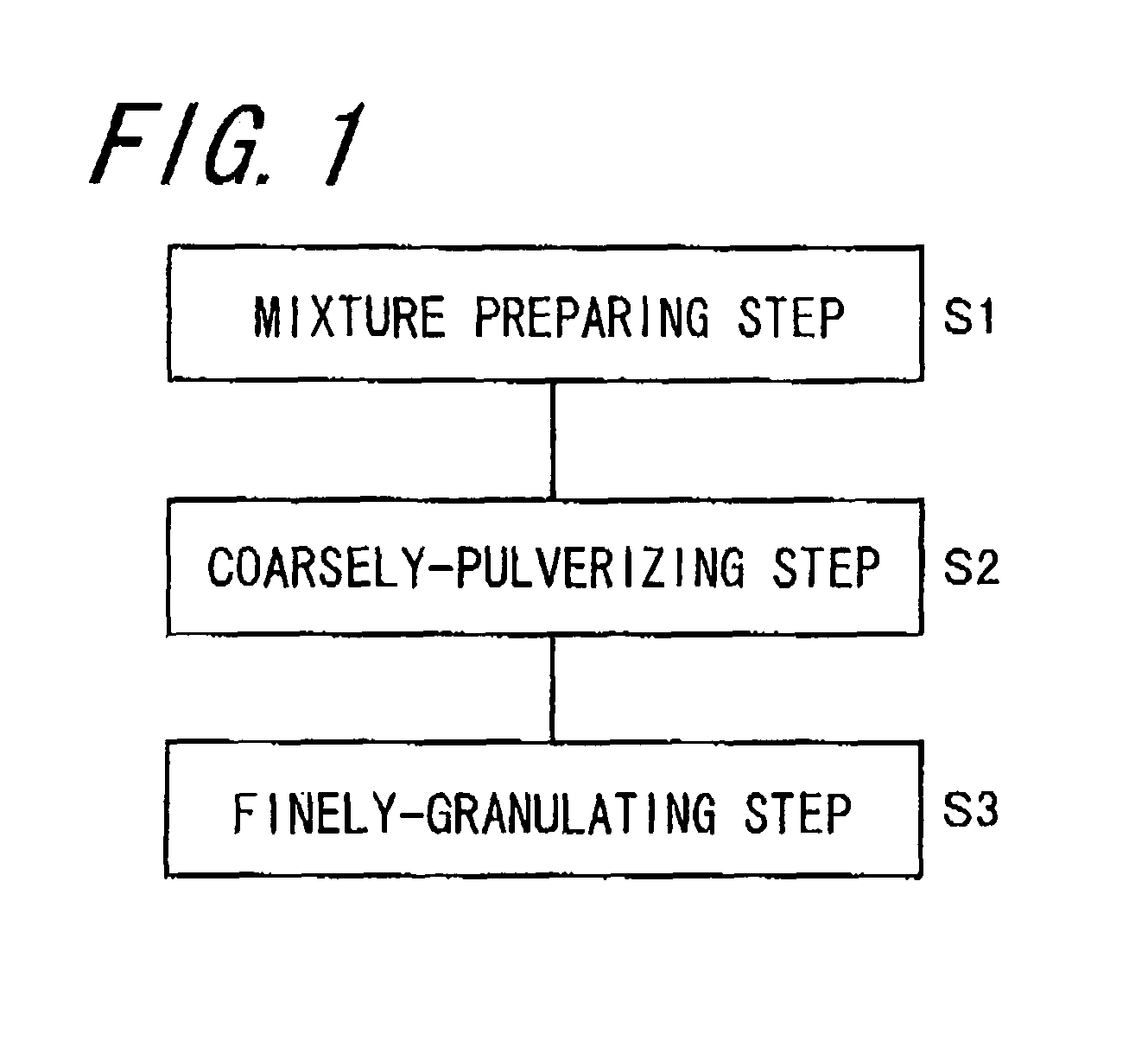Method of manufacturing resin particles
a technology of resin particles and resin particles, which is applied in the field of resin particle manufacturing, can solve the problems of insufficient removal of bubbles and dissolved gases from aqueous medium, inability to disperse pulverized kneaded products in sufficient quantities, and inability to achieve the effect of short tim
- Summary
- Abstract
- Description
- Claims
- Application Information
AI Technical Summary
Benefits of technology
Problems solved by technology
Method used
Image
Examples
example 1
Mixture Preparing Step
[0171]87.5 parts of a polyester resin (glass transition temperature (Tg): 60° C., softening point Tm: 110° C.), 1.5 parts of a charge controller (TRH, trade name of products manufactured by Hodogaya Chemical Industry Co.), 3 parts of a polyester wax (melting point: 85° C.) and 8 parts of a colorant (C.I. pigment red 57:1) were mixed in a mixer (Henschel mixer, trade name of products manufactured by Mitsui Mining Col.), and melt kneaded in a twin screw extruder (PCM-30, trade name of products manufactured by Ikegai Co.) at a cylinder temperature of 145° C. and a number of barrel rotation of 300 rpm. After cooling the melt kneaded raw material to a room temperature, it was pulverized by a cutter mill (VM-16, trade name of products manufactured by Seishin Enterprice Co.) to prepare a molten kneaded product with a volume average particle size of 50 μm and a maximum particle size of 300 μm. The molten kneaded product had a ½ softening point Tm of 110° C. 30 g of the...
example 2
Mixture Preparing Step
[0178]A mixture was prepared in the same manner as in the mixture preparing method of Example 1.
[0179][Coarsely-Pulverizing Step]
[0180]A coarse particle liquid dispersion was prepared in the same manner as in the preparing method for the coarse pulverizate liquid dispersion in Example 1 except for conducting the coarsely-pulverizing treatment for 5 passes at a temperature of the mixture of 67° C.
[0181][Finely-Granulating Step]
[0182]A resin particle liquid dispersion was prepared in the same manner as in the preparing method for the resin particles liquid dispersion of Example 1 to obtain resin particle having a volume average particle size of 1 μm and a coefficient of variation (CV value) of 34%.
[0183][Aggregating Step]
[0184]The aggregated particle liquid dispersion was prepared in the same manner as preparing method for the aggregated particle liquid dispersion of Example 1 to obtain aggregated particles. The obtained aggregated particles had a volume average ...
example 3
Mixture Preparing Step
[0185]A mixture was prepared in the same manner as in the mixture preparing method of Example 1.
[0186][Coarsely-Pulverizing Step]
[0187]A coarse pulverizate liquid dispersion was prepared in the same manner as the preparing method for the coarse pulverizate liquid dispersion in Example 1 except for changing sodium dodecylbenzene sulfonate to 1 g and water to 569 g and conducting the coarsely pulverizing treatment of circulating the mixture in a high pressure homogenizer for 10 minutes at a temperature of 25° C. and under a pressure of 25 MPa for 9 passes.
[0188][Finely-Granulating Step]
[0189]A resin particle liquid dispersion was prepared in the same manner as the preparing method for the resin particle liquid dispersion in Example 1 to obtain resin particles having a volume average particle size of 1 μm and a coefficient of variation (CV value) of 31%.
[0190][Aggregating Step]
[0191]An aggregated particle liquid dispersion was prepared in the same manner as the pr...
PUM
| Property | Measurement | Unit |
|---|---|---|
| particle size | aaaaa | aaaaa |
| diameter | aaaaa | aaaaa |
| softening temperature | aaaaa | aaaaa |
Abstract
Description
Claims
Application Information
 Login to View More
Login to View More - R&D
- Intellectual Property
- Life Sciences
- Materials
- Tech Scout
- Unparalleled Data Quality
- Higher Quality Content
- 60% Fewer Hallucinations
Browse by: Latest US Patents, China's latest patents, Technical Efficacy Thesaurus, Application Domain, Technology Topic, Popular Technical Reports.
© 2025 PatSnap. All rights reserved.Legal|Privacy policy|Modern Slavery Act Transparency Statement|Sitemap|About US| Contact US: help@patsnap.com



